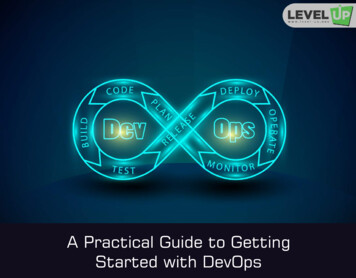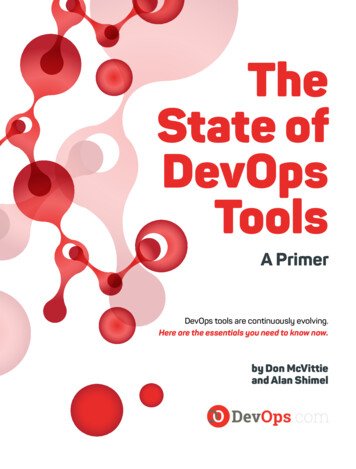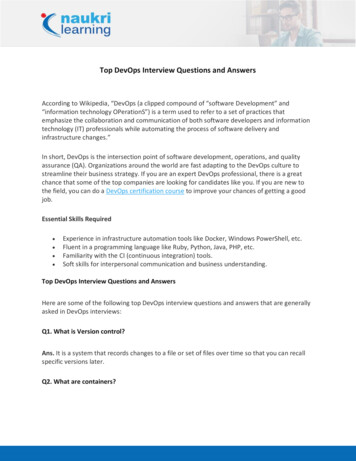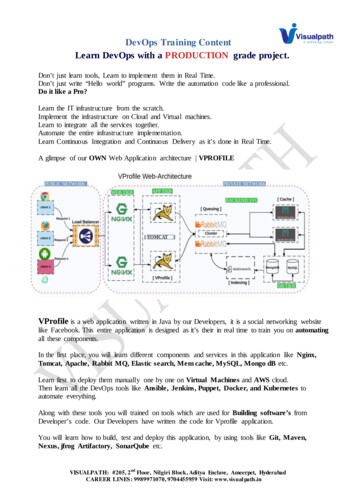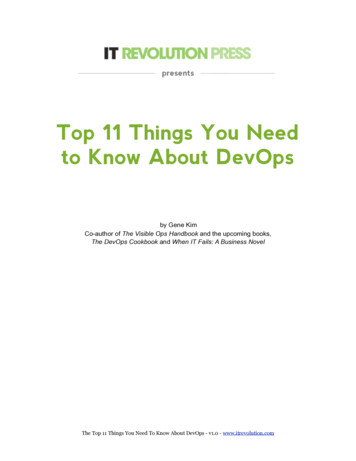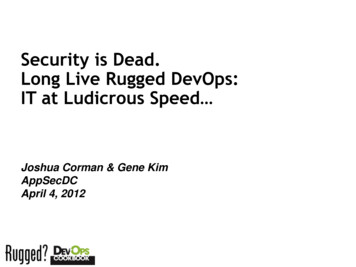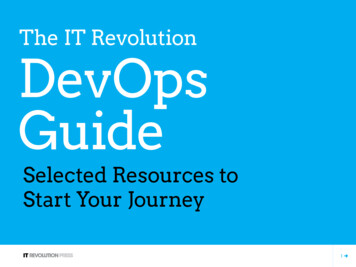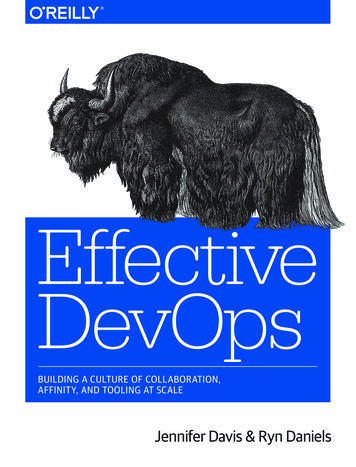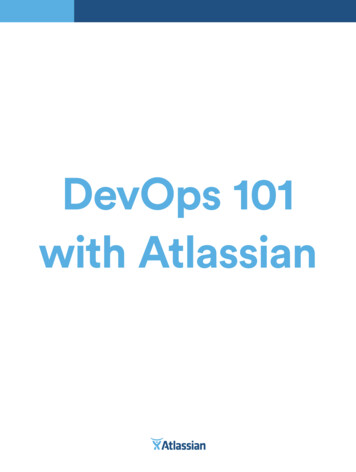
Transcription
DevOps 101with Atlassian
CONTENTSWhat is DevOps?3DevOps and Atlassian6Building Products, DevOps Style9Continuous Delivery for Infrastructure16Handling Incidents at Atlassian24It’s Time for Your DevOps Story28
What is DevOps?Five years ago, Marc Andreesen proclaimed that software is eatingthe world. After all, what company isn’t a software company? Casein point: Modern cars contain hundreds of millions of lines of code—far morethan all of Facebook, from Zuckerberg’s dorm years to today. Even pizza delivery has gone high tech. With advanced mobileapplications for placing orders and tracking deliveries, Dominos Pizzahas increased its IT workforce by 240%. Nike is turning footwear into a fully connected platform by integratingshoes with lifestyle and fitness applications.Old-school development models just don’t hold up to suchhigh-demand, high-growth environments. Traditionally, Developmentand Operations teams work separately in silos, hindering the abilityto move fast. The response to this contentious relationship was amovement called DevOps. It’s a fancy phrase for a simple idea: yourdev and ops teams work better together. It advocates for better3
DEVOPS 101 WITH ATLASSIANcommunication and collaboration so that developing, testing, releasing, and running software can happen more rapidly and reliably.Instead of delivering big, infrequent releases (once every 3 to 9months) like traditional development teams at major enterprises,DevOps takes a “continuous delivery” approach. This meansreleasing small, incremental improvements regularly—often evenseveral times per day.“The results are enormous, and go far beyond the operational.Companies that practiceDevOps are twice aslikely to exceed theirgoals for profitabilityand market share.They also enjoy: 30x more frequent deployments 60% higher change success rates 60x fewer failures 160x faster recoveriesPuppet Labs’ 2015 State of DevOps ReportThese results aren’t limited to major enterprises with billion-dollardev teams, either. You can achieve them yourself, no matter howsmall your team is. The #1 success factor is teamwork. At Atlassian,the key to faster, higher quality releases is a strong relationshipbetween your dev and ops teams, and the right tools and processesin place to support them.So what does that look like at Atlassian, and how did we get started?4
PRO TIPThe #1success factoris teamwork“The #1 success factor is teamwork. At Atlassian, the key to faster, higherquality releases is a strong relationship between your dev and ops teams, andthe right tools and processes in place to support them.”
DevOps and AtlassianCristophe CapelHead of ProductMarketing, JIRAService DeskAt some major big box retailers, really heavy items have “team lift”stickers on them to indicate when several employees need to helpmove the items from shelf to shopping cart. “Team lift” is actually aperfect analogy for the entire DevOps methodology, since DevOpsisn’t any single person’s job—it’s everyone’s job.At Atlassian, we use our own products to understand our uses, andprovide additional testing before we release them to our customers.In short, we dogfood our own products.In this ebook, we’ll cover each step in detail, and exactly how we useeach Atlassian solution. For now, let’s start with our process, whichlooks a bit like a hot tasty pretzel:1. First, we plan the features we will deliver to our customers. We useConfluence and JIRA Software to organize customer feedback and listrequirements. We create issues in JIRA Software to start tracking thestories and epics we define for each software project.2. Then, we build the software—writing code and running tests untilwe get it right. Bitbucket lets us create branches for each new featurewe need to create, and it also allows us to code more collaboratively,6
DEVOPS AND ATLASSIANsince we can use pull requests to facilitate faster reviews, and comment inline and hold conversations between our developers right withinthe code.A cool feature we love: When a developer creates a pull requestto flag new code for team review, Bitbucket automatically updates the related JIRA Software issue status.3. We continuously integrate new features back into a master branchfor deployment. Bamboo makes this easier, helping us automatebuilds, tests, and releases along the way. It really speeds up deployingto AWS, too—we love using Docker and Bamboo together for evenfaster, more efficient deployment.4. JIRA Software’s release hub also gives us full visibility across all ourbranches, builds, pull requests, and deployment warnings, so we canrelease with confidence.5. Once we’ve deployed a new feature into production, it’s time to runand operate it. At Atlassian, our developers are fully responsible forthe features they build, so using JIRA Service Desk helps them trackand resolve incidents faster. We use Confluence to manage run books,knowledge base articles, and related documentation at every step.6. We deliver continuous feedback (via reports, tickets, etc.) to ourdevelopment teams, so they can plan new releases, fix bugs, and deliver faster, more reliable software to our customers. With JIRA ServiceDesk, we can even request customer feedback from both internal andexternal users.Throughout the entire lifecycle, HipChat is the secret salty coating toour pretzel. It adds an additional layer of collaboration on top of ouralready collaborative processes and technology by letting our teamsswarm on incidents, wherever they are, via desktop, mobile apps,and even wearables.That’s just the basics, though, and you came here for details. Solet’s dive in.7
PRO TIPDevOps isn’tany singleperson’s job—it’s everyone’s job.
Building Products,DevOps styleLet’s say your engineering team has gone Agile. They work insprints, collaborate, and are building a lot of great features. Butthere’s just one catch: you still have to wait for the release train toleave the station, and customers aren’t getting value fast enough.Tanguy CrussonProduct Manager,HipChatWe’ll show you our best practices for building products, DevOpsstyle. Let’s start with feedback; because no matter the product, yoursuccess is solely based on your users.How to gather feedback—and use it to shape and build featuresWe’ve learned over the years that the easiest way to make our product better is to listen to the people that use it. Thousands of companies use HipChat, and thousands of Atlassian use it internally, too.You can collect feedback from just about every source imaginable. Ask for in-product feedback Collect user feedback from JIRA Service Desk Monitor social media channels like Twitter and Facebook Use Apdex scores to monitor whetheryour users are satisfied with your service’s response times Gather monitoring data from third party solutions like Datadog and New Relic.What do we do with all that feedback? Here’s what we do with it:Keep in mind: this may or may notwork for your team, but is nonethelessa useful starting framework that youcan tweak.9
BUILDING PRODUCTS, DEVOPS STYLEWe send all feedback to HipChat as notifications. For example, weget a ton of tweets:hey @hipchat, any newsabout deeper JIRAintegration? issue links!Eric Wood @ejwood79We route them, along with allour other social media mentions,bug reports, etc. into dedicatedHipChat rooms where the wholeteam can discuss each notification and help shape our backlog.Important feedback, like bugs, is then converted into a JIRA Software ticket—which we then prioritize into the backlog. If there’s anew feature, we’ll typically create a Confluence page to spec outgoals and requirements.In either case, we make sure to always listen to our customer feedback, wherever they are, and take action when possible.Plan together in sprintsSo, how exactly do we plan what we’re going to build?Our small development teams regroup and meet for an hour everyweek. We use the hour to: Demo everything that was built in the previous week to keep theteam informed and connected. Review the objectives and sprint goals we established the previousweek and agree on whether we achieved them. Define our objectives for our next sprints. At Atlassian, a sprint objective isn’t the same thing as a ticket. A sprint objective is a unit of workthat you have to be able to demo to the team, or ship to production atthe end of the sprint.After the meeting, we break out. With our new objectives in hand,our developers can go through all the issues in our backlog and pickout the ones that will help us achieve the sprint objectives we tookon during the meeting.10
BUILDING PRODUCTS, DEVOPS STYLE11The end result is complete buy-in from the team. Everyone is fullyinvolved in defining our goals, how we are going to achieve them,and how we are dividing the work.Spike early and oftenYou’re probably familiar with the term “spike” in agile development.A spike is a short effort to gather information, validate ideas, identifyearly obstacles, and guesstimate the size of initiatives. Instead ofbuilding a shippable product, we focus on end-to-end prototyping,to arm us with the knowledge we need to get the job done right.At the end of each spike, we have a better idea of the size andtechnical obstacles we will encounter for each initiative, and wecategorize them: Extra Small, Small, Medium, Large, Extra Large, orGodzilla.We regularly rotate between normal sprints and spikes, and holdregular “innovation weeks” that result in really amazing prototypesand insights around project scope and approach. Most teams atAtlassian hold innovation weeks, too, and they love to write aboutthem.
BUILDING PRODUCTS, DEVOPS STYLEKeep even the biggest changes smallInstead of shipping big things infrequently, ship small changes veryoften. It makes it very easy to roll back a particular change if weneed to, or even better: fix and roll forward, and it helps us iteratevery fast.For really big changes—like highly anticipated new features, forexample—we still take a “start small” approach, setting “step bystep” goals and running frequent A/B tests and experiments to seewhat our users like best.“To test, we divide our users intocohorts. For example, cohort AInstead of shipping bigmight see one version of a HipChatfeature, and cohort B might see athings infrequently, shipslightly different version. We looksmall changes very often. at the usage data to see whichversion of the feature is performingbest against the goals we defined during planning—and we keepiterating and testing until we get to the best version of that feature.A tool we use during these testing phases is Launch Darkly, whichlets us release new features to small segments of users, gatherfeedback, and then gradually increase the audience size until we’vefully deployed. We often start with just 5% of users running the newfeature—and then slowly increase by 10 or 15 percent incrementsafter each feedback and revision cycle.12
BUILDING PRODUCTS, DEVOPS STYLEGit Bitbucket Bamboo automated awesomeWe’re heavy users of Git and Bitbucket, using feature branches tomake continuous integration far more effective. Any feature howeversmall, translates into a feature branch, which is automatically testedvia our Bamboo builds.After we test a feature branch, we create a pull request to merge itback to the master branch, and we select a minimum of two reviewers from our team to review and verify the code. Once you get agreen build and 2 approvals, you’re good to go.Since our master branch is what gets shipped to production, werequire that the master be “green”—no known bugs, issues, orerrors—at all times. If a build goes “red,” that means all hands ondeck, and the entire team has to drop everything to fix the build.Encourage accountabilityWe follow one of the main DevOps principles. We’re big on “youbuild it, you ship it, you run it”, meaning the team that is responsiblefor writing a feature also becomes the team responsible for deploying it and providing ongoing maintenance once it’s live.But isn’t that going to introduce a lot of issues in production? In factit’s quite the contrary: It encourages every developer to build thevery best version of something, and gives each of us a vested interest in its ongoing success.What this leads to is 100 developers being able to ship to production at any point in time. This is made possible with the right processand especially the right tools. We use Chef and Puppet for automa-13
BUILDING PRODUCTS, DEVOPS STYLEtion, and developed a number of Chat Apps (HipChat add-ons) tohelp us coordinate this process.Finally, accountability for us also means keeping our users informedof what’s going on. Occasionally, bad stuff happens, and glitcheshave the potential to impact all of our users. We love StatusPage.iofor keeping everyone up to date on the status of all of our services.14
PRO TIPWe’re big on“you build it,you ship it,you run it”We’re big on “you build it, you ship it, you run it”, meaningthe team that is responsible for writing a feature also becomesthe team responsible for deploying it, and providing ongoingmaintenance once it’s live.
Continuous Deliveryfor InfrastructureMichael KnightBuild Engineer,AtlassianIt’s not just development teams that can use DevOps practices. Youcan apply the same practices to your hardware and configurationwork, too. At Atlassian, we’ve built a team of a dozen employees(called Build Engineers) that are dedicated to helping our developers code faster, by giving them the best hardware and infrastructureservices possible. We oversee our continuous integration service(Bamboo), our artifact storage and retrieval service (Sonotype Nexus), and all the hardware, server configurations, applications, andservices that glue them together and provide a smooth experienceto our dev teams.Let’s take a deeper dive into the technology and processes we depend on, and my top tips for running a Build Engineering team moreefficiently and effectively.Gather feedback from developersOur customers are Atlassian’s developers. We used JIRA ServiceDesk to create our own engineering service desk, and that’s howthey contact us to submit requests and provide us with feedback.16
CONTINUOUS DELIVERY FOR INFRASTRUCTURE17“Walk the board” during standupsEach morning, we have standups just like most software dev teams,where we go through all the issues in flight using our Kanban boardin JIRA Software. Each issue is categorized as:TO DOREVIEWREADYMERGEIN PROGRESSROLLOUTWe set a maximum threshold for the number of issues that can bein each status column. Below, you’ll see a few columns that have“gone red” because we’ve exceeded our defined thresholds. Thishelps us determine in our standup that we need to finish the work inthat column before we pick up anything new.
CONTINUOUS DELIVERY FOR INFRASTRUCTUREPull requests: swarms, approvals and keeping things greenWe create branches for any hardware or configuration change, nomatter how small, exactly the same way that our software development colleagues do. Every single pull request is linked to a JIRAissue, and we manage the pull requests in Bitbucket, requiring twoapprovals from our colleagues (plus a green feature branch build) tomove forward.Our team also has a HipChat room where we wrote a bot to keeptrack of all our pull requests. It shows all open pull requests, andhow close they are to being merged. We leave it up to the team toswarm over the pull requests and jump in and provide feedback forthe ones they feel most qualified to review. Everyone pitches in andworks really well to move us through the pipeline faster and knockout our in-process work.So HipChat, JIRA Software, JIRA Service Desk, and Bitbucket are abig part of our day-to-day operations.18
CONTINUOUS DELIVERY FOR INFRASTRUCTUREFavorite Pipeline ToolsYou might be wondering what tools to use for handling software,configuration, and hardware deployments. Here are a few of ourfavorites:Software PipelineJust like our software development team, we use Bamboo onthe infrastructure side, to manage and run our build plansand deployments. We useBamboo to manage Puppet,where we write new modulesto install and configure components on our servers, like amodel to install the SSH keys from everyone on our team.Vagrant lets us spin up test servers easily, which we apply Puppetconfigurations to for testing purposes. Puppet and Vagrant integratereally well, and the combination makes it really easy to test newAWS server configurations automatically.Cucumber is great for testing, too. We use it to confirm that ouragents are installed properly, and that the changes we have madehaven’t broken anything.Once we’re finished testing a configuration or change, we deploy ournew Puppet tree out to production, and HipChat will automaticallypost a notification to the issue assignee to verify that the change isworking in production, and to also close the issue in JIRA.As always, Bamboo shows the status of the build, and the detailsof each release, like which environments it’s been deployed to, andwhich JIRA issues are addressed in each build and release.19
CONTINUOUS DELIVERY FOR INFRASTRUCTUREHardware pipelineBamboo manages everythingin our hardware pipeline aswell, from start to finish. Sincewe make heavy use of AmazonWeb Services (AWS), we useTerraform to manage our hardware infrastructure. We love itbecause it allows us to use software best practices and workflowsto make changes to our hardware.For example: Changes we request to our hardware infrastructurethrough Terraform have to be verified through pull requests, anddeployed through a continuous delivery pipeline—the same processour software developers have to follow for their work. This keeps usconsistent about how we manage quality across the board.Here’s a quick example of what Terraform code looks like, just incase you’re curious:Here, we’re basically setting up a new NAT server on AWS. We usecode to set all the parameters, like subnet, etc. We can feed anentire hardware configuration into Terraform, and it will figure out allthe API calls it needs to make to AWS to change our server topography from its current state to what is specified by the code. Then, we20
CONTINUOUS DELIVERY FOR INFRASTRUCTUREcan ask Terraform to execute the plan and make those changes. It’smagical.We track all of these releases with Bamboo, just like we do oursoftware. Bamboo deploys each Terraform release into our stagingenvironment first, and then our production environment once we’reready. Bamboo is also used to see which releases have been deployed across what environments.Three core concepts to rememberNothing changed the game more for our team than the idea of“infrastructure as code.” It’s allowed us to adopt software development’s best practices, but apply them to hardware and configurationmanagement, and it’s greatly improved the stability of our platform.Doubling the number of servers dedicated to running Bamboo atAtlassian was pretty much the same amount of work as just addingone would have been in a less efficient model.Our team follows three basic principles that pretty much any engineering team can adopt:1. Automate everythingIt’s critical that our builds work. If we don’t test them thoroughly, wecan’t be confident they will work. Automated testing helps preventregressions, gives us confidence in our changes, and makes continuous delivery possible for us.We automate notifications, too, and just about anything we can toreduce human error and make sure we don’t miss important tasks.Finally, with more automation, we can keep our team smaller. Thatmeans less communications overhead, and more speed—which isexactly our team’s charter.2. Stay focused on continuous deliveryStable hardware and reliable configurations are critical to makingsure our developers can get their work done. So we follow continuous delivery best practices, just like they do: OUR CODE IS ALWAYS RELEASABLEOur master is always “green” and stable, so it can be released at anytime.21
CONTINUOUS DELIVERY FOR INFRASTRUCTURE WE RELEASE FREQUENTLYThis reduces risk, since there are only small changes from release torelease, and we can revert easily as needed.“ WE FOCUS ON FAST VALUE DELIVERYSince our users are Atlassian developers, we want them happy. Continuous delivery ensures we get improvements and fixes out to them asquickly as possible.As a result, we’re ableto perform 10x morebuilds, without addinga single person to ourengineering team.3. Embrace infrastructureas codeSimply put, this just means that weexecute code to automatically configure servers, apps, and more insteadof manually configuring them via other less efficient methods like in-toolconfiguration screens and wizards.We can literally use code to hammer out commands like “give me Nservers configured with apps X, Y, and Z”, and then use review andapproval workflows to reduce human error significantly.As a result, we’re able to perform 10x more builds, without adding asingle person to our engineering team. We can deploy with far higher confidence, and more independence.22
PRO TIPWith moreautomation, wecan keep ourteam smaller.That means lesscommunicationsoverhead, andmore speed.
Handling incidentsat AtlassianNick WrightHead of ServiceOperations,AtlassianBut what about when things aren’t working as planned—like whena feature rolls out that isn’t performing optimally? That’s where ourService Operations team comes in. Our job is to make it easier tospot and fix incidents, and prevent them from happening again inthe future.We use ITIL as the basic framework for our service managementpractice. It gives us a standard set of terminology and processesthat make it easier to communicate and work together. More specifically, ITIL provides a strong foundation for how to classify incidents,define severity, and perform and track investigations into root causeand more.Let’s take a look at how Atlassian handles incidents when the poop(or anything else, really) does eventually hit the fan.1. Someone (or something) reports the incidentWe learn about system outages and other potential performanceglitches in two ways: Our users raise incidents using JIRA Service Desk Our monitoring systems (like Cacti, DataDog, Zabbix, and Nagios)send us a notification24
HANDLING INCIDENTS AT ATLASSIAN2. We aggregate the alerts into HipChatWe aggregate all of our incident alerts into a single stream in a HipChat room, so our teams get directly informed that there is a problem. This can sometimes generate noise, so we turn to tools like BigPanda to help out. BigPanda correlates massive amounts of IT alertsand events, and helps group them together, saving us a ton of time.3. We create an incident ticketOccasionally, a team may know the outage was caused by a changethey just made, and they can quickly disable that change. But moreoften than not, we need to pull a team together to troubleshoot andresolve something. The first step is to raise an incident ticket in JIRAService Desk.To create a ticket, we enter a few details, like a short name and description of the vent, and then categorize each incident by the impact it could have on a service, the number of users impacted, andhow urgently it should be handled.4. We notify our usersWe use StatusPage.io to communicate with internal and external stakeholders, and push updates with incident status at regular intervals.25
HANDLING INCIDENTS AT ATLASSIAN5. We create a dedicated chat room and swarm to resolvethe incidentWithin the incident ticket in JIRA Service Desk, we use the “createa room” feature to move the conversation to a dedicated HipChatroom and pull in the right team to solve the problem at hand. Theteam discusses what went wrong, and agrees on an approach fortroubleshooting and fixing it.6. We resolve and categorize the root causeITIL recommends that we categorize each issue (bug, license expiry, infrastructure or configuration issue, etc.) once we’ve identifiedthe root cause and taken corrective action. We also document thecorrection actions we took as well, and can use all of this information to run detailed reports highlighting our most common incidenttypes and more. This helps us to take a more preventative approachto incident and problem management.7. Finally, we conduct a post-mortem and document whatwent wrongPossibly the most critical step to resolving an incident is learningfrom it. At Atlassian, we have a couple of different options for tracking the post-incident review activities: JIRA or Confluence. Confluence lets us configure templates for a standard incident reportlayout, and it’s easy to get started quickly. JIRA, on the other hand,26
HANDLING INCIDENTS AT ATLASSIANlets us build structured workflows that guide teams through thepost-incident review process, and allow us to track each post-mortem review through to completion.We’ve used both successfully. More important than the technology you use in the post-mortem process is making sure that youare able to develop a good understanding of the root cause of youroutage. Use that to take the right set of actions to prevent the sameoutage from occurring again.Our top recommendations: CAPTURE THE DATA WHILE IT’S FRESH IN YOUR MINDWe use a JIRA workflow we developed to walk our team membersthrough the entire incident report process, complete with target timeframes for each step. MAKE SURE YOU DOCUMENT EVERYTHING IN YOUR KNOWLEDGE BASEWe write all our incident reports in Confluence (and link to them fromJIRA), so we can refer back to them for future similar incidents andensure we keep getting smarter (and sharing the knowledge) along theway. AUDIT YOUR RESULTS REGULARLYWe run reports in JIRA to make sure our team is doing a good job ofresolving incidents and of documenting the results.By introducing better workflow and diagnosis tools and following astandardized approach to incident and problem management, we’vereduced our mean-time-to-diagnosis from 113 minutes to just 23minutes—and we’re committed to cutting it even more.27
It’s Time for YourDevOps StoryIn this ebook, we’ve given you a quick glimpse at how Atlassiandoes DevOps behind our own walls. We’ve profiled how our software development teams use continuous development practices,and how our Build Engineering team follows those very same guidelines to manage our hardware and configuration infrastructure withtremendous efficiency. We’ve looked at the Atlassian and third partytools both teams use to increase our throughput and quality, andwe even looked at how standardized frameworks like ITIL help us toresolve incidents faster and more efficiently when issues inevitablyarise at Atlassian.But what about your story? We’d love to hear the different ways thatDevOps is powering your business. The more unique, the better.Submit your storyExplore our tools for DevOps28
DEVOPS 101 WITH ATLASSIAN Companies that practice DevOps are twice as likely to exceed their goals for profitability and market share. Puppet Labs’ 2015 State of DevOps Report “ communication and collaboration so that developing, testing, releas-ing, a

